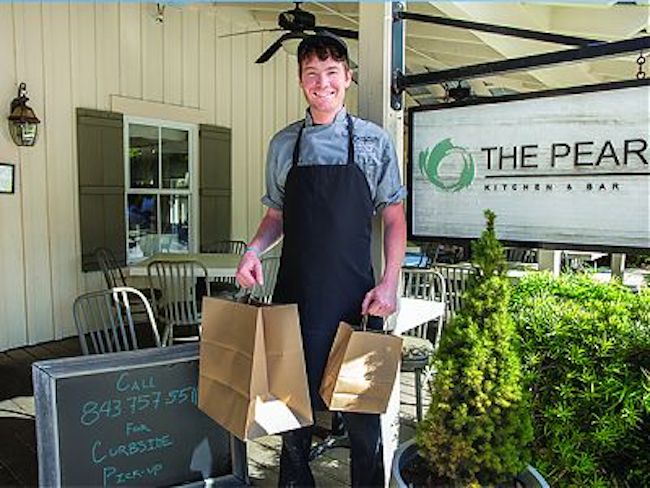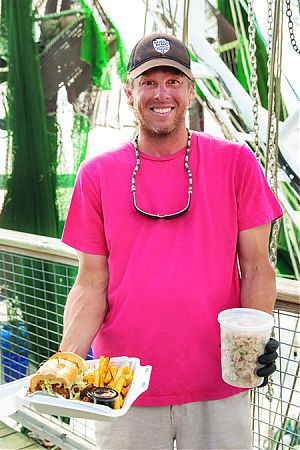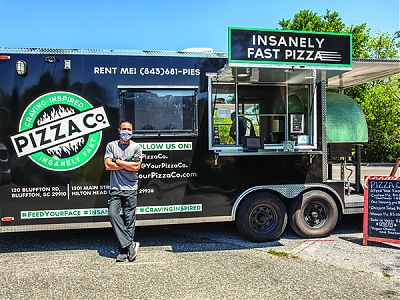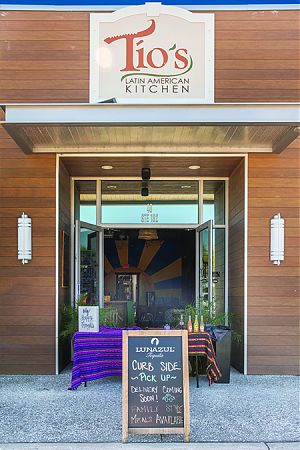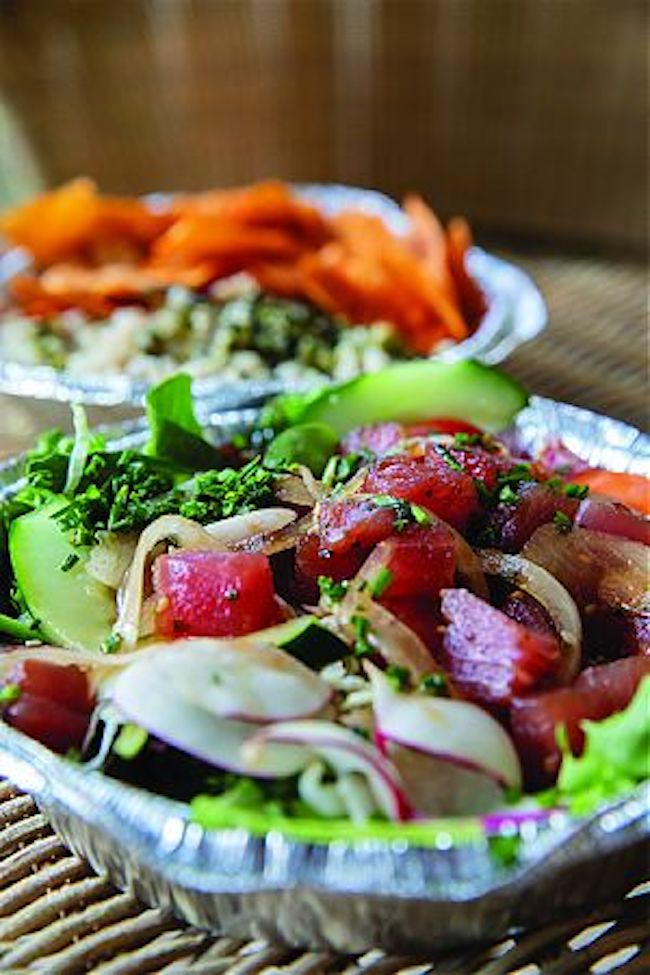Through hurricanes, evacuation orders, a workforce shortage and fluctuating tourist seasons, Hilton Head Island and Bluffton hospitality leaders have learned to be versatile, strategic, and positive through challenging circumstances. When Governor Henry McMaster ordered all South Carolina restaurants to close dine-in services, local restaurant owners immediately sought other streams of revenue to navigate these unfamiliar waters. From offering gift cards to creating family meal deals, Hilton Head Island restaurant owners have been experimenting with new concepts to stay afloat amidst the COVID-19 crisis.
Changing hours, menus, and prices can be expected, but some innovators have altered their core essence to keep customers happy, workers employed, and money coming in. Time will tell if these strategies will hold them over until the day they can return to normal operations.
“Right now we’re spending equal time creating or marketing these other streams of income that were so minor before, but now we really need to make them a larger part,” Tio’s Latin American Grill owner Sally Zuniga said.
For Lowcountry restaurant owners, this couldn’t have come at a worse time. March is the beginning of tourism season—the time so many depend on after months of slow business in the offseason.
Compounding the impact, is the absence of the RBC Heritage golf tournament, Easter weekend, and spring break crowds. Moreover, a cloud of uncertainty veils the summer season and potentially beyond. Thankfully, resilient restaurant owners aren’t focused on those considerations.
“You can’t let yourself go there,” Hudson’s Seafood on the Docks owner Andrew Carmines said. “The biggest lesson in all of this is that you just have to say positive and keep swinging.”
Other influential islanders told us that ‘attitude is everything’ in this crisis. “You really have to expect the unexpected and don’t get overwhelmed with what you can’t control,” Santa Fe Cafe and Pizza Co. owner Marshall Sampson said. “We’ve just tried to work with what’s available to us and serve what we can the best in the best possible way—that’s what we’re focused on.”
Getting creative
Lowcountry restaurant owners are doing whatever it takes to survive in the COVID-19 pandemic. For Andrew Carmines, this means tossing every idea in the air and seeing if any stick. “I’m constantly strategizing every single day, and the difficult thing about this coronavirus is that the information and everything changes every six hours, and then the strategy changes every six hours,” Carmines said. “So, it’s really about being flexible and viable in an environment that is constantly changing.”
Carmines said in a lot of ways, hurricanes have prepared him for this. “You’re constantly getting thrown off and you constantly have to adjust.”
To survive and thrive, businesses of any kind must get creative, finding any stream of revenue to make up for recent catastrophic losses. At Nick’s Seafood Restaurant, owners Josh Protch and Katie Hopkins offered buy-one-get-one (BOGO) deals. “Deals like this always work well,” Nick’s owners said. “It was our best plan to help the community as well as bring money in for our staff.”
At Hudson’s, Carmines recently implemented a revolutionary adaptation to existing policy that resulted from a long-time customer’s suggestion. Consequently, and for a limited time, Hudson’s offered special gift cards that would guarantee a highly-coveted and previously unavailable “reservation” in the busy season. Located on top of Skull Creek, Hudson’s boasts some of the best views of the Lowcountry. In the summer months, they can have more than a two-hour wait. Carmines said they went for the idea and soon sold out of the special reservation-guaranteeing gift cards.
“It will be really cool when we get up and running again to really thank those people who helped us out during such a tough time,” Carmines said. “We will be sure to thank them in person and really roll out the red carpet for those customers.”
Owners at Tio’s, Slapfish, Pearl, Santa Fe Cafe and Hudson’s said gift cards have been a helpful way to make up for lost revenue.
Starting fresh
Zack Lamasney and family were in a unique predicament from the beginning (they were open less than two weeks before McMaster shuttered dine-in services). In the making for two years, their fast-casual concept, appropriately titled Slapfish, focused on local seafoods and Lowcountry hospitality.
Before COVID-19 entered the popular lexicon, Slapfish owners designed a walk-up, bike-up window on the side of the restaurant. “We didn’t know if it was going to work, but it’s been a great way to get customers their orders without having to come inside the store,” Lamasney said. “It’s been really successful.”
Slapfish has also experimented with delivery in these troubled times. “If you order from Slapfish, an owner will be delivering your meal,” Lamansey said, explaining that one of his
family members delivers every delicious meal.
Changing up everything
For fine dining restaurants like Pearl, the transition to take-out is a lot more difficult. “We’ve had to change everything up,” owner Alex Nightingale said. Changing everything up means reducing the number of items on menus, reducing prices on some items, creating plates with more value and offering deals that will help attract new clientele. But as much as they’ve had to adapt and change, Pearl understands that they also have to keep some things the same to appeal to their usual customer base.
Nightingale noted, “We know there’s a lot of clientele out there who like fresh fish and local products and things like that. And we’re keeping some of those things on the menu because there’s a certain expectation there.”
Taking advantage of available technology, Pearl’s Alex Nightingale said they recently launched an online ordering platform that has helped boost take-out sales. “I was surprised by the amount of people who I guess don’t want to call and would rather just enter their order online.”
It’s not all gloom and doom
Restaurants can now sell beer or wine from a sealed container in South Carolina. At Pearl, they’re using that to get more customers in the door by offering 20 percent off all bottles of wine and free bottles of wine for any order over $150. “It’s been good to see how many people will order a few more items to get to that $150 mark,” Nightingale said. “It’s another way to appease our audience.”
And at Pearl, the customers are giving back, too. “Gift certificates have been another great way for customers to help their favorite restaurants out,” Nightingale said. “We’ve had a few loyal customers who have come in and bought several hundreds of dollars worth of gift certificates.”
A lot of restaurants, including Pearl and Tio’s, added family-style dinners to their menus as another way to get customers ordering. “Catering in larger quantities and family meals, that’s something we have to focus on,” Zuniga said. “We’re making it easy to feed families as opposed to just doing takeout because so many people are in the same exact predicament.”
Work it
Without dine-in services, restaurants that care about their employees have found other activities for their team members. At Pearl, they’ve done renovation projects inside the restaurant. Tio’s employees are helping deliver food. And perhaps most impressive, Hudson’s employees are helping catch soft shell crabs. Hudson’s is then selling those crabs to-go with tips on how to prepare.
“You know we really went back and forth on if we should do it or not, but it’s been really successful,” Carmines said. “Soft shell crabs and shrimp are one of our best cost items because we produce them ourselves.
Also, because we are producing them ourselves, it creates work hours for employees that otherwise wouldn’t be working.”
Fighting stigma
Zuniga said she’s seen a lot of people on local Facebook groups say they are hesitant about ordering from local restaurants for sanitary reasons. “I’ve seen people saying they feel more comfortable getting food from a grocery store and preparing it themselves. But I personally believe that getting your food from a restaurant would be safer than shopping in the grocery store. And the reason being is because the majority of the restaurants have such extremely limited staff right now.”
At restaurants like Tio’s, there is a very limited amount of people coming in contact with your food, and those workers are trained in food safety and food handling, Zuniga said. “You know, when you think about it, restaurant workers have trained for COVID since the beginning of time. We go through a box of gloves a night, and sometimes on a busy night, we use 200 sets of gloves in the kitchen.”
Food truck success
Food trucks—the ultimate social distancing cuisine—are seeing success amidst the impact of COVID-19 here in the Lowcountry. Sampson said his Pizza Co. food truck has been in a good position this last month. “The food truck is busier than it’s ever been.”
Sampson went on to say the COVID-19 crisis has forced them to get creative—and that meant moving their food trucks to spots they hadn’t thought of before. “When this whole thing started, my wife and I went to different neighborhood boards and asked if we could set up shop sometime. It’s gotten a great response.”
The Pizza Co. food truck is booked out for the next few weeks. “Going into the neighborhoods with the food truck has really opened a whole new world for us versus finding public locations,” Sampson said.
He said customers and employees have been very careful to maintain social distance. “Our crew wears masks, and customers have been really good about maintaining a good distance from the window. Some neighborhoods were worried about crowds, but we haven’t seen that at all.”
Giving back
A new organization has been set up to help Hilton Head and Bluffton restaurant workers survive the COVID-19 crisis. The Watterson Family Foundation teamed up the Hilton Head Island- Bluffton Chamber of Commerce to create the Help 4 Hope Fund. This fund is raising money with a goal of $5 million to help local restaurants and hospitality workers get through the worst of the crisis.
“It’s helping in two tiers,” Sampson said. “It’s helping people get food, but it’s also helping the restaurants kind of stay afloat. The restaurants then turn those cards back to the foundation to receive $50 for each card they bring in. It’s really helping a lot of people with a really good idea. Participants on all sides of this program have seen a lot of great support so far.”
The upside
Even with mounting pressure and seemingly insurmountable challenges ahead, the most resilient in our community remain stalwart. Like Andrew Carmines said, “Every time you’re in a situation where it’s all negative, you have to try to find the positive.”

